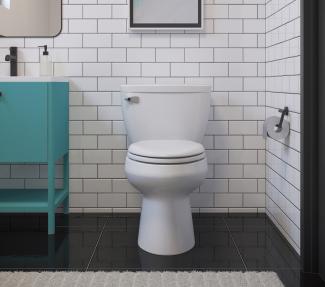
Facilities face significant challenges when it comes to water usage in restrooms. Leaking toilets, inefficient designs, and outdated fixtures contribute to excessive utility bills and environmental waste. Traditional gravity-based toilets – though still widely used – often fall short in providing the performance and reliability needed to support modern sustainability goals.
That’s where pressure-assist toilets offer a game-changing solution.
Featuring proven technology, pressure-assist toilets are engineered to optimize water savings, reduce maintenance costs, and provide consistent, high-performance flushing. To shed light on the benefits of this approach, we spoke with Russell Horner, President of Water Management, Inc., a water efficiency service firm serving the multifamily, hospitality, and commercial markets for over 45 years. Water Management has earned a reputation as a trusted expert in delivering cost-effective, long-term solutions for facility managers and property owners that create real value through practical efficiency.
How do energy and utility providers help businesses lower water consumption and reduce operational costs?
Many utility providers offer rebates and incentive programs that encourage businesses to replace outdated toilets with high-efficiency models. These programs often provide the financial motivation needed to move from older, inefficient systems to modern units using as little as 1.28 gallons per flush (gpf) or less.
In fact, the vast majority of toilets Water Management has installed in the past decade operate at 1.0 gpf or less, offering superior performance and water savings compared to older 1.6 gpf units – many of which are unknowingly using more than their rated capacity due to miscalibrations or worn parts.
Switching to pressure-assist toilets removes the guesswork. These systems deliver consistent performance while helping businesses reduce operational costs and meet their sustainability goals.
Why should businesses prioritize restroom upgrades when targeting water conservation and cost reduction?
Restrooms are often the largest single point of water use in a building. Leaking toilets, outdated parts, and neglected maintenance result in thousands of gallons of water being wasted each year – and many facilities operate this way for years without realizing it.
In contrast, pressure-assist toilets eliminate hidden leaks, resist internal component failure, and provide reliable flushing over time. The environmental and financial return on investing in upgraded restroom systems is both immediate and long-lasting.
What advantages do pressure-assist toilets offer compared to traditional gravity fixtures?
The most obvious benefit is superior flush performance. Pressure-assist systems use compressed air to generate powerful and consistent flushes. This makes them ideal for high-traffic commercial environments, where gravity systems often degrade under constant use.
Additionally, pressure-assist technology helps avoid two major issues:
1. Clogs and backups, which damage customer satisfaction and increase maintenance costs.
2. Hidden leaks, which are extremely common in gravity toilets and contribute heavily to inflated water bills.
EPA studies show that leaking toilets can waste up to 180 gallons of water per week, or nearly 10,000 gallons per year. At Water Management, we regularly come across gravity toilets leaking more than 1,000 gallons per day. With pressure-assist systems, that problem is nearly eliminated.
What challenges do businesses face when upgrading to water-efficient toilets—and how can they be addressed?
The most common concern we hear is upfront cost. Pressure-assist toilets are often priced higher than gravity-based models. But when you calculate the total cost of ownership, including water savings, reduced maintenance, and longer-lasting performance, the investment pays off quickly.
Another challenge occurs when facilities attempt to achieve commercial-level performance without considering plumbing requirements. For example, commercial fixtures require service lines to the building of 1½” or larger. If larger service lines are not present it will compromise performance. Pressure-assist systems strike an effective balance – they offer commercial-grade performance without the need for major plumbing upgrades.
Can businesses track and quantify water savings from pressure-assist toilets?
Absolutely. We strongly recommend that businesses track water bills before and after implementation. At Water Management, we often install data-logging meters that record usage every minute. This high-resolution data is ideal for identifying usage trends, quantifying savings, and quickly detecting leaks or anomalies.
In many buildings, restrooms account for at least 30–50% of total water consumption. Replacing inefficient or leaking fixtures with pressure-assist toilets offers immediate and measurable impact. Additionally, standard gravity toilets – especially older models – frequently flush at volumes far above their design, sometimes up to 3 gallons per flush due to fill and flush valve issues. Pressure-assist systems eliminate this risk by delivering consistent, calibrated flushing every time.
A Final Note on Long-term Value
Unlike HVAC or lighting systems that may lose efficiency but don’t “leak” energy, plumbing failures directly waste water, often in large volumes. Gravity-based flush valves and fill components typically require recommissioning every 2–4 years, depending on water quality. In contrast, Flushmate pressure-assist systems extend that maintenance window by a factor of three or more.
Indirect savings also play a big role: pressure-assist toilets reduce maintenance calls, minimize downtime, and prevent costly overflows and water damage. With water and sewer rates continuing to rise annually, high-quality plumbing fixtures—like those from Flushmate—pay for themselves and are a cornerstone of any well-designed water efficiency program.
Bottom line: If your facility is still relying on outdated restroom fixtures, it’s time to consider pressure-assist toilets. The efficiency, reliability, and cost savings they provide make them a smart investment for any commercial property focused on sustainability.